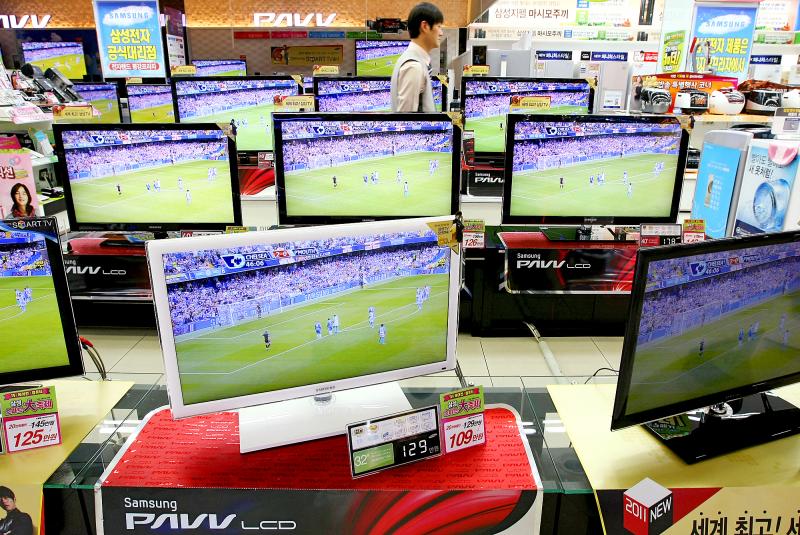Samsung Display Co’s plans to continue manufacturing LCD panels in South Korea are not expected to affect market dynamics in the first half of this year, but might exacerbate a supply glut during the second half, market researcher TrendForce Corp (集邦科技) said in a note on Thursday.
The display unit of Samsung Electronics Co last week said that it would extend its production of panels for TVs and monitors due to COVID-19-driven demand, reversing its announcement in March last year that it would end all production by the end of the year to pursue a technology upgrade.
“Despite previous expectations [that it would] shutter its LCD panel manufacturing operations, Samsung Display will continue manufacturing panels in South Korea, with one 7-generation and two 8.5-generation production lines operating throughout the first quarter of 2021,” TrendForce said.

Photo: Bloomberg
“However, in consideration of costs, technological transition schedules and client demand for specific panel sizes, Samsung Display is expected to retain manufacturing operations at only one 8.5-generation production line in the fourth quarter of 2021,” the Taipei-based research firm said, adding that Samsung Display’s continued panel manufacturing is expected to conclude by the end of this year.
Given persisting component shortages, coupled with steady demand for display panels used in TVs, monitors and laptops, overall LCD panel supply and demand is predicted to mostly remain balanced until the end of the first half, despite Samsung Display’s plan to extend LCD manufacturing, TrendForce said.
However, the research firm did not rule out the possibility of a supply glut in the second half, even though Samsung Display has pledged to sell all of its panels to Samsung Electronics, which has historically been the largest purchaser of display panels, it said.
“The increased panel supply from Samsung Display certainly represents a potential risk that may disrupt the panel industry’s supply and demand equilibrium,” TrendForce said. “Whether Samsung Electronics will shift its panel purchasing strategies in response [to the supply of panels from Samsung Display] will remain an important point of observation for the panel market in 2021.”
In related news, NH Investment & Securities Co expects LCD panel prices, which were high at the end of last year, to continue rising in the first quarter due to an anticipated decrease in glass substrate supply.
That is because Japan-based glass substrate maker Nippon Electric Glass Co (NEG) had a power outage for five hours in its Takatsuki plant in Japan on Dec. 10, the Seoul-based securities firm said in a note on Wednesday.
As the incident damaged five glass furnaces at the Takatsuki plant and might affect NEG’s shipments for about a quarter, NH Investment said that South Korean panel makers and their Taiwanese peers could find it hard to source glass substrate in the short term, which would maintain panel prices into the first quarter.
LCD panel prices would likely remain flat in the second quarter compared with the first quarter due to an acceleration in panel production alongside normalized supply of glass substrates, the securities firm said.
However, panel prices are forecast to decline from the third quarter, as supply should exceed demand due to ongoing production expansion by Chinese manufacturers, centering on facilities that are eighth generation and above, NH Investment said.

Taiwan Semiconductor Manufacturing Co (TSMC, 台積電) last week recorded an increase in the number of shareholders to the highest in almost eight months, despite its share price falling 3.38 percent from the previous week, Taiwan Stock Exchange data released on Saturday showed. As of Friday, TSMC had 1.88 million shareholders, the most since the week of April 25 and an increase of 31,870 from the previous week, the data showed. The number of shareholders jumped despite a drop of NT$50 (US$1.59), or 3.38 percent, in TSMC’s share price from a week earlier to NT$1,430, as investors took profits from their earlier gains

In a high-security Shenzhen laboratory, Chinese scientists have built what Washington has spent years trying to prevent: a prototype of a machine capable of producing the cutting-edge semiconductor chips that power artificial intelligence (AI), smartphones and weapons central to Western military dominance, Reuters has learned. Completed early this year and undergoing testing, the prototype fills nearly an entire factory floor. It was built by a team of former engineers from Dutch semiconductor giant ASML who reverse-engineered the company’s extreme ultraviolet lithography (EUV) machines, according to two people with knowledge of the project. EUV machines sit at the heart of a technological Cold

AI TALENT: No financial details were released about the deal, in which top Groq executives, including its CEO, would join Nvidia to help advance the technology Nvidia Corp has agreed to a licensing deal with artificial intelligence (AI) start-up Groq, furthering its investments in companies connected to the AI boom and gaining the right to add a new type of technology to its products. The world’s largest publicly traded company has paid for the right to use Groq’s technology and is to integrate its chip design into future products. Some of the start-up’s executives are leaving to join Nvidia to help with that effort, the companies said. Groq would continue as an independent company with a new chief executive, it said on Wednesday in a post on its Web

CHINA RIVAL: The chips are positioned to compete with Nvidia’s Hopper and Blackwell products and would enable clusters connecting more than 100,000 chips Moore Threads Technology Co (摩爾線程) introduced a new generation of chips aimed at reducing artificial intelligence (AI) developers’ dependence on Nvidia Corp’s hardware, just weeks after pulling off one of the most successful Chinese initial public offerings (IPOs) in years. “These products will significantly enhance world-class computing speed and capabilities that all developers aspire to,” Moore Threads CEO Zhang Jianzhong (張建中), a former Nvidia executive, said on Saturday at a company event in Beijing. “We hope they can meet the needs of more developers in China so that you no longer need to wait for advanced foreign products.” Chinese chipmakers are in